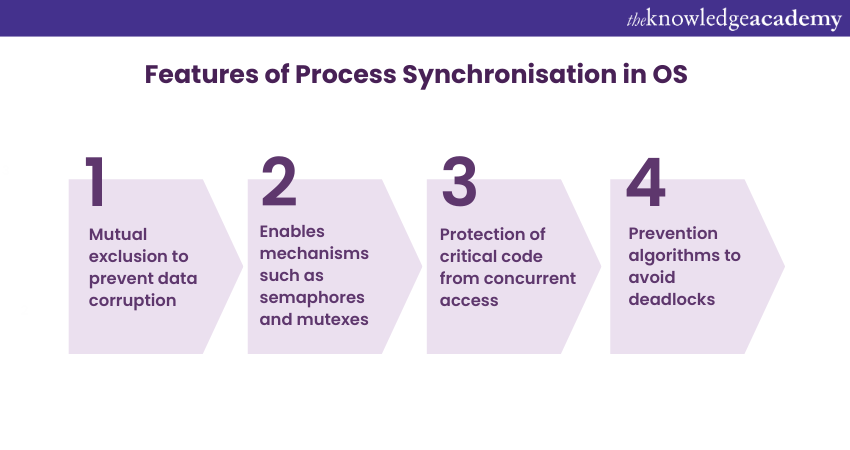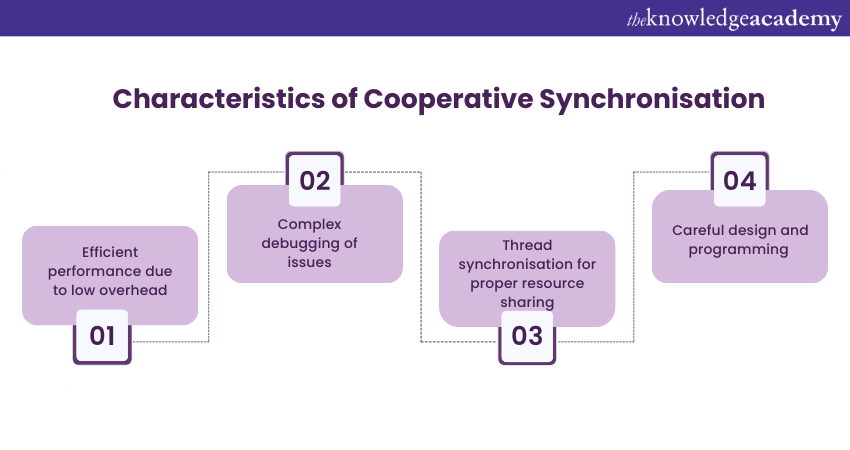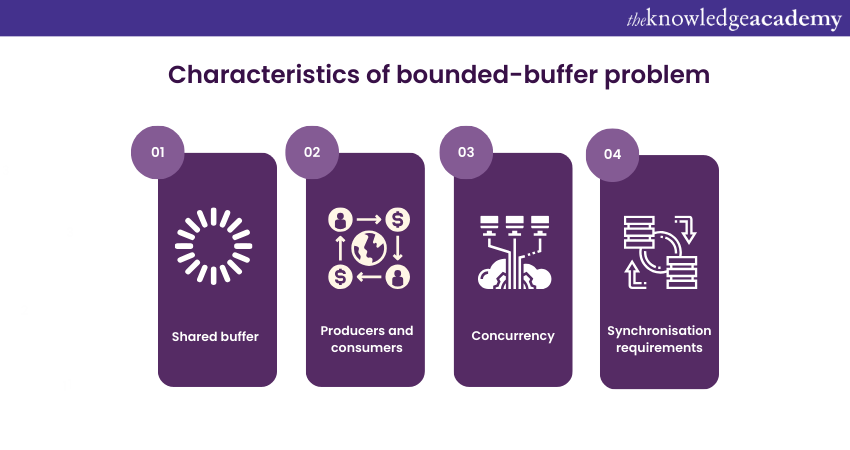We may not have the course you’re looking for. If you enquire or give us a call on +44 1344 203 999 and speak to our training experts, we may still be able to help with your training requirements.
We ensure quality, budget-alignment, and timely delivery by our expert instructors.

Akin to the blend of various instruments in an orchestra to produce harmonious melodies, Process Synchronisation orchestrates concurrent processes in an Operating System to create a coherent and orderly performance.
The process pivots on the concept of harmonised interactions among processes, preventing conflicts and data dissonance. It ensures that shared resources are used responsibly, maintaining data integrity and resource allocation fairness.
Table of Contents
1) What is Process Synchronisation in Operating System?
2) How does Process Synchronisation Work in OS?
3) Types of Process Synchronisation in OS
4) Example of Process Synchronisation
5) Importance of Synchronisation in Operating System
6) What is Critical Section Problem?
7) Solutions for Critical Section Problem
8) Conclusion
What is Process Synchronisation in Operating System?
Process Synchronisation is a fundamental concept in the field of Operating Systems, crucial for managing multiple concurrent processes or threads effectively. It is basically the coordination and control of these processes to ensure they execute in a harmonious and orderly manner, avoiding conflicts and undesirable race conditions.
Now, the primary goal of Process Synchronisation is to maintain data integrity, manage shared resources, and prevent concurrency-related issues like data corruption, deadlock, and contention.
There are certain objectives that can be achieved through Process Synchronisation with the use of mutexes, semaphores, condition variables, monitors and spinlocks. Here are the key objectives of Process Synchronisation described briefly as follows:
a) Mutual exclusion: Ensuring that only one process at a time can access a critical section of code or a shared resource, preventing simultaneous access that might lead to data corruption.
b) Deadlock avoidance: Implementing strategies and mechanisms to prevent situations where multiple processes are stuck, each waiting for a resource held by another, effectively leading to a standstill.
c) Orderly execution: Establishing a sequence of execution for processes, ensuring that they do not interfere with each other's tasks, thereby maintaining predictability and preventing unexpected outcomes.
d) Fair resource allocation: Distributing resources fairly among competing processes, avoiding resource contention and ensuring that no process is unfairly starved of essential resources.
Create effective and interactive websites by signing up for Web Development Training now!
How does Process Synchronisation work in OS?
Process Synchronisation is a critical aspect of Operating Systems that ensures the harmonious and predictable execution of multiple concurrent processes. It revolves around preventing conflicts and race conditions when processes access shared resources or critical sections of code. To understand how Process Synchronisation works in Operating Systems, here are the various mechanisms and concepts that underpin this crucial functionality:

a) Mutual Exclusion: One of the foundational concepts in Process Synchronisation is mutual exclusion. It ensures that only one process can access a critical section at a time, preventing multiple processes from simultaneously modifying shared resources, which could lead to data corruption. Achieving mutual exclusion is crucial, and several synchronisation mechanisms are designed to enforce it.
Synchronisation mechanisms: Various synchronisation mechanisms are used to enforce mutual exclusion and facilitate Process Synchronisation. These include:
1) Semaphores: Semaphores are integer variables that act as counters to control access to shared resources. They can be used to signal between processes, allowing one process to enter a critical section while blocking others.
2) Mutexes or Mutual Exclusion: Mutexes are binary variables that serve as locks. When a process locks a mutex, it signifies that it has access to a critical section. Other processes attempting to lock the same mutex will be blocked until it is released.
3) Condition variables: Condition variables are used in conjunction with mutexes. They allow processes to wait for specific conditions to be met before proceeding. Condition variables are effective in scenarios where a process should pause its execution until a certain condition is true.
4) Monitors: Monitors are a higher-level synchronisation construct that encapsulates both data and procedures into a single unit. They provide a structured approach to synchronisation, making it easier to manage concurrent access to shared resources.
5) Spinlocks: Spinlocks are simple locks that repeatedly check for availability until they can acquire the lock. They are efficient when the expected wait time is brief and are often used in low-level Operating System code.
Critical sections: A critical section is a segment of code that accesses shared resources or data structures that must be protected from concurrent access. Process Synchronisation mechanisms ensure that only one process or thread can execute a critical section at a time.
Deadlock avoidance: Process Synchronisation also addresses the issue of deadlocks, which occur when processes are stuck and unable to proceed because they are waiting for resources held by others. Techniques like deadlock detection and prevention algorithms are used to ensure that deadlocks are minimised or resolved when they occur.
Orderly execution: Process Synchronisation establishes a sequence of execution for processes, allowing them to interact with shared resources in a controlled and orderly manner. This ensures that processes do not interfere with each other's tasks and maintains the predictability of their execution.
Understanding these features and mechanisms is essential for comprehending how different types of operating systems manage concurrent processes and maintain system stability.
Types of Process Synchronisation in OS
Process Synchronisation in Operating Systems can be categorised into two primary types, namely Cooperative Synchronisation and Independent Synchronisation. These types differ in their approach to managing concurrent processes and ensuring their orderly execution.
Additionally, the choice between these types depends on the specific requirements and characteristics of the application and the level of control and efficiency needed to ensure the orderly execution of concurrent processes.
Here are the two types of Process Synchronisation in OS explained in further detail:
Cooperative Synchronisation
Cooperative Synchronisation, also known as non-pre-emptive synchronisation, relies on processes voluntarily cooperating and explicitly coordinating with each other. In this approach, processes communicate and synchronise based on shared agreements, making it their responsibility to avoid conflicts and ensure a harmonious execution. This contrasts with Independent Synchronisation, where the system enforces stricter control, much like the importance of booting in system management.
The key characteristics of Cooperative Synchronisation include the following:

a) Low overhead: Since processes cooperate willingly and typically do not incur the overhead of system intervention, this approach tends to be more efficient in terms of performance.
b) Increased complexity: Cooperative Synchronisation requires careful design and programming practices. Developers must ensure that processes adhere to synchronisation protocols, which can be challenging to implement correctly.
c) Risk of misbehaviour: If processes do not follow the established synchronisation rules, there is a risk of conflicts and data corruption. Debugging such issues can be complex.
d) Examples: Many user-level synchronisation mechanisms, such as thread synchronisation in a multi-threaded application, are often cooperative in nature. These threads must cooperate to access shared resources properly.
Independent Synchronisation
Independent Synchronisation, also known as pre-emptive synchronisation, relies on the Operating System's kernel to enforce synchronisation and control process execution. In this approach, processes do not have direct control over their execution order. Instead, the Operating System intervenes to ensure orderly execution.
The key characteristics of Independent Synchronisation include:
a) Higher overhead: Since the Operating System is responsible for enforcing synchronisation, there is a higher overhead associated with context switches and managing the execution of processes.
b) Enhanced control: Independent Synchronisation allows the Operating System to enforce synchronisation and prevent processes from accessing shared resources simultaneously. This enhances control and reduces the risk of conflicts.
c) Simplicity for programmers: Application developers do not need to worry about explicitly synchronising processes. They rely on the Operating System's mechanisms, which simplify programming but can result in less efficient solutions.
d) Examples: Operating System-level synchronisation mechanisms, such as the use of mutexes and semaphores in multi-process applications, are often independent. The Operating System ensures that processes access shared resources safely.
Learn to program in the top used languages by signing up for our Programming Training now!
Example of Process Synchronisation
There are two key examples of Process Synchronisation in Operating Systems, which are described as follows:
Bounded-buffer problem
It is a classic example of Process Synchronisation and concurrent programming. It represents a scenario where multiple processes or threads are involved in the production and consumption of data in a shared, fixed-size buffer or queue.
Moreover, this problem is a fundamental illustration of how to ensure that producers and consumers can work concurrently without issues such as overflows or underflows.
The key characteristics of the bounded-buffer problem include:

a) Shared buffer: There is a shared, fixed-size buffer with a limited capacity. This buffer can store a predefined number of items, which is typically referred to as the buffer size.
b) Producers and consumers: Two types of processes or threads are involved in this problem, namely producers and consumers. Producers generate data items and attempt to place them in the buffer, while consumers retrieve and process items from the buffer.
c) Concurrency: Both producers and consumers run concurrently, which means that they can access the shared buffer at the same time. This concurrent access necessitates synchronisation mechanisms to ensure that the buffer is not overfilled or emptied prematurely.
d) Synchronisation requirements: The primary challenge in the bounded-buffer problem is to coordinate the actions of producers and consumers so that they do not violate the buffer's size constraints. Producers should be blocked when the buffer is full, and consumers should be blocked when the buffer is empty.
Readers-Writers problem
The Readers-Writers problem is a classic example in the field of Process Synchronisation that illustrates the challenges of managing concurrent access to shared data. It involves two types of processes, namely readers and writers, both of which want to access a shared resource, typically a data structure.
This problem highlights the importance of maintaining data integrity and ensuring that readers and writers can operate concurrently while preventing potential data inconsistencies or conflicts.
The key characteristics of the Readers-Writers problem include:
a) Readers: Readers only want to read the shared resource, and their operations are generally non-destructive. Multiple readers can safely access the resource simultaneously without causing issues.
b) Writers: Writers, on the other hand, want to modify or update the shared resource. Their operations are potentially destructive, and only one writer should be allowed access at a time to prevent data corruption.
c) Concurrency: The problem introduces concurrency, as both readers and writers can coexist and need to access the shared resource efficiently.
d) Synchronisation requirements: The primary challenge in the Readers-Writers problem is to coordinate and synchronise the actions of readers and writers to ensure that data consistency is maintained while allowing for concurrent access. It is essential to balance the need for data integrity with the goal of maximising resource utilisation.
Importance of Synchronisation in Operating System
Synchronisation is crucial in an Operating System for various reasons, and its importance can be summarised as follows:
a) Data integrity: Synchronisation ensures that shared data structures remain consistent, preventing data corruption due to concurrent access.
b) Resource allocation: It manages and allocates resources fairly among competing processes, preventing resource contention.
c) Orderly execution: Synchronisation mechanisms establish a sequence of execution for processes, maintaining order and predictability.
d) Deadlock avoidance: It plays a pivotal role in preventing deadlock situations where processes are stuck, and unable to proceed.
e) Concurrency control: Synchronisation allows multiple processes or threads to work together without causing conflicts, ensuring that they do not interfere with each other's tasks.
f) Real-time systems: In real-time environments, synchronisation guarantees that tasks are executed within specified time constraints, a critical requirement for mission-critical applications.
g) Efficient resource utilisation: It helps optimise resource utilisation by allowing multiple processes to share resources without overloading or underutilising them efficiently.
h) Preventing race conditions: Synchronisation prevents race conditions and ensures that shared resources are accessed in a controlled manner, eliminating unpredictable behaviour.
Get acquainted with the foundations of programming by signing up for our Object Oriented Programming (OOPs) Course now!
What is Critical Section Problem?
The Critical Section Problem is a foundational concept in concurrent computing and Process Synchronisation. It refers to a segment of code within a program where shared resources or data are accessed and modified.
Now, the problem revolves around ensuring that only one process or thread can execute this critical section at any given time, preventing data corruption or undesirable outcomes caused by concurrent access.
Moreover, to solve the Critical Section Problem, synchronisation mechanisms like semaphores, mutexes, or other forms of locks are employed to coordinate access and guarantee exclusive execution of the critical section, thereby maintaining data integrity and system reliability.
Solutions for Critical Section Problem
Various solutions have been developed to tackle the Critical Section Problem, each addressing the challenge of ensuring exclusive access to shared resources among multiple processes or threads:
a) Locks and Mutexes: Employing locks or mutexes allows processes to acquire a lock before entering the critical section, ensuring mutual exclusion.
b) Semaphores: Semaphores act as counters, allowing processes to signal and wait to enter the critical section, enforcing synchronisation.
c) Monitors: Monitors encapsulate data and procedures into a single unit, simplifying synchronisation by offering built-in mechanisms for access control.
d) Spinlocks: Spinlocks repeatedly check for resource availability, offering a lightweight synchronisation solution but potentially leading to high CPU usage.
e) Conditional variables: Used alongside locks, conditional variables enable processes to wait until specific conditions are met, reducing busy-waiting overhead.
f) Software Transactional Memory (STM): STM systems provide a higher-level abstraction for concurrent data access, reducing the need for explicit locks.

Conclusion
We hope that you have now gotten acquainted with the concept of Process Synchronisation in Operating Systems. Process Synchronisation ensures the orderly and conflict-free execution of concurrent processes. It safeguards data integrity, promotes resource fairness, and prevents deadlock. Utilising various synchronisation mechanisms, it forms the backbone of stable and efficient computing systems.
Frequently Asked Questions
Upcoming Programming & DevOps Resources Batches & Dates
Date
 Web Development Training
Web Development Training
Fri 17th Jan 2025
Fri 21st Feb 2025
Fri 4th Apr 2025
Fri 6th Jun 2025
Fri 29th Aug 2025
Fri 24th Oct 2025
Fri 26th Dec 2025







 Top Rated Course
Top Rated Course


 If you wish to make any changes to your course, please
If you wish to make any changes to your course, please


